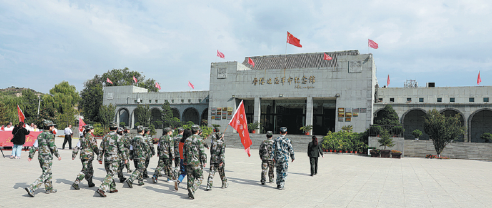Caijiaya earns reputation as destination for red tourism
Updated: 2021-02-19

The Jinsui Revolutionary Memorial Hall in the village of Caijiaya is a major red tourism destination in Shanxi province. [Photo by Yan Zhongxing for China Daily]
Local people say village has undergone remarkable growth in the past decade
In early and mid-February when China celebrated its annual Spring Festival, the village of Caijiaya in Xingxian county in the west of Shanxi province welcomed hundreds of daily visitors.
In many ways, Caijiaya seems to be an ordinary village near the Weifen River, a branch of the Yellow River, in the heart of the Lyuliang Mountains.
However, more than 80 years ago, it was part of the Jinsui Revolutionary Base, home to the headquarters of the 120th division of the Eighth Route Army led by famed Chinese general He Long (1896-1969). The army was stationed there to protect Yan'an in Shaanxi province, the cradle of the Chinese Communist revolution during China's War of Resistance Against Japanese Aggression (1931-45) and China's War of Liberation (1945-49).
Today, the Jinsui Revolutionary Memorial Hall in Caijiaya remains a silent witness to the past. Red tourism, which focuses on tours exploring the history of the Communist Party of China before the founding of the People's Republic of China in 1949, has grown tremendously during the past few years.
With tourists flocking to this red tourism destination, local residents have had opportunities to improve their livelihoods with new sources of revenue.
Ren Jinfeng, 58, is a local resident who works as a street cleaner near the memorial hall.
The woman has had the job for eight years and witnessed great changes in the village since it became a destination for red tourism a decade ago.
"Most of our fellow villagers have benefited from the red tourism industry," Ren said. "Life can be improved if you are willing to work hard."
The woman said street cleaning is not a highly paid job, but "it ensures a stable source of revenue for me".
Ren said the income has helped her support her three children through their education.
"I'm proud that all my children have graduated from universities and found jobs," Ren said.
At the western end of the village, Wen Xi'er, another local resident, sells freshly steamed bean curd at his small stall.
The vendor said he has been making and selling bean curd for more than 30 years. But his business had renewed prosperity in recent years.
"I used to sell bean curd mainly to locals, with sales standing at tens of kilograms a day," Wen said. "The income was barely enough to support a family and we needed other jobs to make ends meet."
But sales began to increase as more tourists came to his village.
"Now I sell more than 200 kg a day, which means a net income of more than 200 yuan ($31)," Wen said.
"My bean curd is popular among tourists because it's organic and has a special taste that comes from a rustic kitchen," he explained.
Tourists take the bean curd back to their homes in Taiyuan, Xinzhou and even as far as the Inner Mongolia autonomous region. There have also been orders from afar requiring delivery of dried bean curd.
Wen Feiyue is a Caijiaya native who works as a kindergarten teacher in Beijing. She returned to her hometown in late January with several friends she invited to visit the famous red tourism site.
"Travel is much easier now as there is a special train service between Taiyuan and Caijiaya," Wen Feiyue said.
"I come back almost every Spring Festival, and every time I return I see things changing for the better."
According to He Jianjun, head of the Caijiaya Party committee, the village was lifted from poverty in 2015, with per capita annual income reaching 7,200 yuan that year.
"A number of tourism facilities have been built or are under construction in the village, including a recently completed tourist service center and a large car park scheduled to open this May," He said. The projects will help the village accommodate more tourists and bring in more revenue.
Yan Zhongxing contributed to this story.



